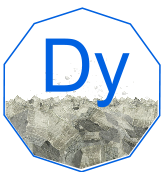Dysprosium

Dysprosium (Dy)
General Information
- Symbol: Dy
- Atomic Number: 66
- Atomic Weight: 162.500 u
- Element Category: Lanthanide
- Group: N/A (Lanthanides series)
- Period: 6
- Block: f-block
Physical Properties
- Appearance: Silvery-white metallic
- Density: 8.54 g/cm³
- Melting Point: 1412 °C (2574 °F)
- Boiling Point: 2562 °C (4644 °F)
- Phase at STP: Solid
- Electron Configuration: [Xe] 4f¹⁰ 6s²
- Oxidation States: +3 (most common)
Chemical Properties
- Reactivity: Dysprosium is fairly reactive, slowly oxidizing in air. It reacts with water to form dysprosium hydroxide and with acids to form dysprosium salts.
- Compounds: Forms compounds such as dysprosium(III) oxide (Dy₂O₃), dysprosium(III) chloride (DyCl₃), and dysprosium(III) nitrate (Dy(NO₃)₃).
Uses and Applications
- Magnets: Used in high-strength permanent magnets, especially in neodymium-based magnets to improve their performance at high temperatures.
- Nuclear Reactors: Used in control rods and neutron-absorbing materials due to its high neutron absorption cross-section.
- Lighting: Dysprosium iodide is used in metal-halide lamps for high-intensity lighting.
- Lasers: Dysprosium-doped crystals are used in certain types of solid-state lasers.
- Data Storage: Used in magneto-optical data storage.
Occurrence and Extraction
- Natural Occurrence: Found in minerals such as xenotime, monazite, and bastnasite, often alongside other rare earth elements.
- Extraction: Extracted through complex processes involving the crushing of ore, magnetic separation, and solvent extraction.
Isotopes
- Stable Isotopes: Dysprosium-156, Dysprosium-158, Dysprosium-160, Dysprosium-161, Dysprosium-162, Dysprosium-163, Dysprosium-164 (most stable)
- Radioactive Isotopes: Several radioactive isotopes, including Dysprosium-154 and Dysprosium-165, used in research.
Safety and Handling
- Hazards: Dysprosium compounds are considered to have low toxicity, but dust and powders should be handled carefully to avoid inhalation or ingestion. Metallic dysprosium can be a fire hazard in powder form.
- Precautions: Use appropriate protective equipment when handling dysprosium and its compounds.
History
- Discovery: Discovered by Paul Émile Lecoq de Boisbaudran in 1886.
- Name Origin: The name “dysprosium” comes from the Greek word “dysprositos,” meaning “hard to get at.”
Additional Facts
- Crystal Structure: Hexagonal close-packed (hcp) at room temperature; body-centered cubic (bcc) at high temperatures
- Magnetic Properties: Paramagnetic at room temperature; ferromagnetic below 85 K
- Thermal Conductivity: 10.7 W/m·K
- Electrical Resistivity: 0.926 µΩ·m at 20°C
Summary
Dysprosium is a versatile lanthanide with a wide range of applications in industry and technology. It is particularly valuable in high-strength permanent magnets, nuclear reactors, and high-intensity lighting. Discovered in 1886 and named after the Greek word for “hard to get at,” dysprosium is found in several minerals and requires careful handling due to its reactive nature.
40 Question and Answer Pairs About Dysprosium
What is the atomic number of Dysprosium?
- 66
What is the symbol for Dysprosium?
- Dy
What is the atomic weight of Dysprosium?
- 162.500 u
In which group of the periodic table is Dysprosium found?
- Lanthanides series (no specific group)
What period is Dysprosium in?
- Period 6
What block does Dysprosium belong to?
- f-block
What is the density of Dysprosium?
- 8.54 g/cm³
What is the melting point of Dysprosium?
- 1412 °C (2574 °F)
What is the boiling point of Dysprosium?
- 2562 °C (4644 °F)
What is the electron configuration of Dysprosium?
- [Xe] 4f¹⁰ 6s²
What are the common oxidation states of Dysprosium?
- +3 (most common)
What is the appearance of Dysprosium?
- Silvery-white metallic
Is Dysprosium reactive with air?
- Yes, it oxidizes slowly.
Name a compound of Dysprosium.
- Dysprosium(III) oxide (Dy₂O₃)
What is a common use of Dysprosium in magnets?
- In high-strength permanent magnets.
How is Dysprosium used in the nuclear industry?
- In control rods and neutron-absorbing materials.
What role does Dysprosium play in lighting?
- Dysprosium iodide is used in metal-halide lamps.
How is Dysprosium used in lasers?
- Dysprosium-doped crystals are used in solid-state lasers.
What is a data storage application of Dysprosium?
- Used in magneto-optical data storage.
How is Dysprosium typically found in nature?
- In minerals such as xenotime, monazite, and bastnasite.
What are the stable isotopes of Dysprosium?
- Dysprosium-156, Dysprosium-158, Dysprosium-160, Dysprosium-161, Dysprosium-162, Dysprosium-163, Dysprosium-164
What safety hazard is associated with Dysprosium dust?
- It can be a fire hazard.
Who discovered Dysprosium?
- Paul Émile Lecoq de Boisbaudran
Where does the name Dysprosium come from?
- From the Greek word “dysprositos,” meaning “hard to get at.”
What is the crystal structure of Dysprosium at room temperature?
- Hexagonal close-packed (hcp)
Is Dysprosium paramagnetic or diamagnetic at room temperature?
- Paramagnetic
What is the thermal conductivity of Dysprosium?
- 10.7 W/m·K
What is the electrical resistivity of Dysprosium at 20°C?
- 0.926 µΩ·m
What is the primary oxidation state of Dysprosium in its compounds?
- +3
Is Dysprosium found as a free element in nature?
- No, it is found in minerals.
What is the common name of Dysprosium(III) chloride?
- DyCl₃
What is a major application of Dysprosium in the magnet industry?
- In high-strength permanent magnets.
How does Dysprosium benefit the nuclear industry?
- As a neutron absorber in control rods.
What is the melting point of Dysprosium in Kelvin?
- 1685 K
What group does Dysprosium belong to in the periodic table?
- Lanthanides series
What is the natural abundance of Dysprosium-164?
- It is one of the stable isotopes.
Can Dysprosium be used in high-temperature applications?
- Yes, particularly in alloys and magnets.
What is the key property that makes Dysprosium valuable in magnets?
- Its ability to improve performance at high temperatures.
How is Dysprosium used in the chemical industry?
- Mainly in research and specialized applications.
What precautions should be taken when handling Dysprosium?
- Use appropriate protective equipment to avoid inhalation or ingestion.






